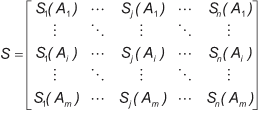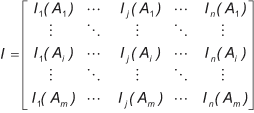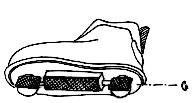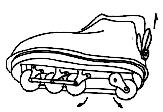|
|
|
|||||||||
|
|||||||||
By Kai Ming Yu, C.T. Lau, K.L. Tong and W.K. Wong
In new product development, idea generation that is innovative, able to be manufactured and profitable is important. For discrete consumer products or technical systems, creative idea generation techniques advocated by psychologists, and practiced by management consultants, are usually too general for engineers. A successful product needs to implement most (if not all) functions specified in the client statement and a multitude of factors identified from consumer and competitor analyses.
Optimization techniques, however, will suit more for detailed design. QFD (quality function deployment) may link up various product development stages with the voice of the customer (VOC), but alternatives are ranked by simple weights. This paper proposes an integrated approach for inventive idea generation and multi-criteria decision-making during conceptual design. The Theory of Inventive Problem Solving (TRIZ) is employed for generating idea systematically for technical problems, while superiority and inferiority ranking (SIR) will be used for more comprehensive alternative selection. Details on how the methods complement each other to achieve innovative product development will be explained, along with an illustrative practical example.
TRIZ, SIR, new product development, conceptual design
New product development (NPD) is important to the growth of every company because it can contribute toward creating improved products and services, which give competitive edge to the company.21 In new product development, generation of ideas that are innovative, able to be manufactured and profitable is important. Design with consideration of downstream activities has been well accepted since 1982.23 Quality function deployment attempts to link up various NPD stages with the voice of customer.1 For discrete consumer products or technical systems, creative idea generation techniques advocated by psychologists and practiced by management consultants are usually too general for engineers.
For instance, there is the five-step model of the creative process: preparation, incubation, intimation, illumination and verification.34 Edward De Bono developed lateral thinking to provoke creativity.15 A successful product needs to include most (if not all) functions specified in the client statement and a multitude of factors identified from consumer and competitor analyses. Design optimization, however, using cost function minimization cannot be done in the conceptual design stage; alternatives in QFD are ranked by simple weights. Tools are needed that can provide truly innovative ideas rather than simply creative or inventive ones.
Engineering design includes conceptual, embodiment and detailed design stages.27 A typical product development workflow is shown in Figure 1. As the famous inventor C. F. Kettering once said, "A problem well-stated is a problem half-solved," the conceptual design stage is further broken down into more steps (Figure 2). The integration of concept clarification, generation and selection ensures efforts and budgets are properly spent in NPD activities.
| |||||
| |||||
TRIZ was developed by Genrich Altshuller and his colleagues in the former U.S.S.R. starting in 1946, and is now practiced throughout the world.3,4,5
TRIZ research is based on the hypothesis that there are universal principles of invention for creative innovations driven by advanced technology. If these principles can be identified and codified, it makes the process of invention more predictable. More than two million patents have been examined, classified by level of inventiveness and analyzed to look for the principles of innovation. The three primary findings of this research are:
In TRIZ, the forty principles and the contradiction matrix are the most accessible tools.32,17 Contradictions occur when trying to improve one characteristic or parameter of a technical system causes another characteristic or parameter of the system to deteriorate. A compromise solution is usually sought. In TRIZ, however, truly innovative solutions are those that resolve contradictions. In this technique, a technical system can be featured by several of thirty-nine generic characteristics (Table 1), such as weight, size, brightness, speed, strength, etc. Two characteristics define a contradiction that can be solved by studying the principles (Table 2) suggested in the contradiction matrix.28
| Table 1: 39 Characteristics (Parameters) in the TRIZ Contradiction Matrix | |
| C1: Weight of a mobile object | C21: Power |
| C2: Weight of a stationary object | C22: Loss of energy |
| C3: Length of a mobile object | C23: Loss of substance |
| C4: Length of a stationary object | C24: Loss of information |
| C5: Area of a mobile object | C25: Loss of time |
| C6: Area of a stationary object | C26: Amount of substance |
| C7: Volume of a mobile object | C27: Reliability |
| C8: Volume of a stationary object | C28: Accuracy of measurement |
| C9: Speed | C29: Accuracy of manufacturing |
| C10: Force | C30: Harmful factor acting on an object from outside |
| C11: Tension/pressure | C31: Harmful factor developed by an object |
| C12: Shape | C32: Manufacturability |
| C13: Stability of composition | C33: Convenience of use |
| C14: Strength | C34: Reparability |
| C15: Time of action of a moving object | C35: Adaptability |
| C16: Time of action of a stationary object | C36: Device complexity |
| C17: Temperature | C37: Difficulty of detecting and measuring |
| C18: Brightness | C38: Extent of automation |
| C19: Energy spent by a moving object | C39: Productivity |
| C20: Energy spent by a stationary object | |
| Table 2: 40 Inventive Principles in the TRIZ Contradiction Matrix | |
| P1: Divide an object into independent parts | P21: Skipping |
| P2: Removal/extraction | P22: Convert harm into benefit |
| P3: Local quality | P23: Feedback |
| P4: Asymmetry | P24: Intermediary |
| P5: Merging | P25: Self-service and self-organization |
| P6: Universality | P26: Copying |
| P7: Nested structures | P27: Inexpensive short-lived objects |
| P8: Anti-weight | P28: Mechanics substitution |
| P9: Preliminary anti-action | P29: Pneumatics and hydraulics |
| P10: Preliminary action | P30: Flexible shells and thin films |
| P11: Beforehand cushioning | P31: Porous materials and membranes |
| P12: Equipotentiality | P32: Color changes |
| P13: Reverse | P33: Homogeneity |
| P14: Spheroidality – curved | P34: Discarding and recovering |
| P15: Dynamism | P35: Parameters and properties changes |
| P16: Partial, satiated or excessive actions | P36: Phase transitions |
| P17: Another dimension | P37: Thermal expansion |
| P18: Mechanical vibration | P38: Strong oxidants |
| P19: Periodic action | P39: Inert atmosphere |
| P20: Continuity of useful action | P40: Composite materials |
Another focus in conceptual design is on the solution selection process. In order to prevent parameter conflicts during product innovation development, there can be a list of solutions. Multi-criteria decision aid (MCDA) provides tools and procedures to help the decision makers achieve the desired solution in the situation of ambiguous and uncertain product environments. Instead of yielding a single solution, MCDA establishes a kernel of preferred solutions. Solving multi-criteria problem does not search out the hidden truth, but helps decision makers master the complex data involved in the problem and advance to a solution.33 MCDA can solve decision problems:
All MCDA models exhibit certain constraints:
When compared to other creative concept generation methods, like brainstorming, brainwriting 6-3-5, QFD, etc., TRIZ is better-suited to inventive engineering solutions.20 As such, requirements specified in client statements will be formulated in terms of the thirty-nine engineering characteristics of TRIZ. In order to compare the relative importance of the objectives or the translated characteristics, weights are assigned as appropriate. The weights are also used in the SIR analysis of the alternatives (from in-house or competitors). For these purposes, a weighted objectives tree will be constructed from the client statement in which the leaves in TRIZ characteristics serve as criteria for alternative selection.
The importance of different objectives and sub-objectives of product design with weighted objectives can be ranked and compared to variants by visualizing their weight value profiles.27 The assignment, calculation and comparison of relative weights to the objectives and sub-objectives can be constructed into a weighted objectives tree.14 An objectives tree is better-suited for quick concept clarification while substance-field analysis and ARIZ better for detailed design.19
As the SIR method can handle both ordinal and cardinal data, permits the use of different preference structures by the decision-makers and is able to measure the superiority and inferiority intensities of alternatives, it is used for multi-criteria alternative selection in the integrated method. The proposed conceptual design is shown in Figure 3.
| |||||
SIR – Generalized Criteria
A multi-criteria problem is first formulated by using a set of alternatives (A1, A2 ¡ … Am) and criteria (g1, g2 ¡ … gn) and letting gj(Ai) be the criteria value or performance of the ith alternative Ai with respect to the jth criterion gj. Decision-makers need to assign thresholds and weightings for each criterion and alternative, and assign levels of performance gn(.) for each criterion. Then a (m by n) decision matrix, D, is formulated as follows:
The level of performance can be measured as indices, numerical constants or values in different units for different criteria. Decision makers can choose from any of the six different preference structures shown in Figure 4 and Table 3 according to their knowledge about the criteria.10,11,31
| |||||
| |||||
With the difference in criteria d = g(A)-g(A')e (-a,a) and the intensity of the preference P(A,A') = f(g(A) – g(A')) = f(d)e[0,1], the parameters p and q are respectively the preference and the indifference thresholds, while e is the Gaussian standard deviation. Types 1, 2 and 4 are discrete functions while Types 3, 5 and 6 are fuzzy, i.e., the latter functions deal with grey areas between strict preference and indifference among alternatives.
Intensities of Superiority and Inferiority
After all gn(.) are determined, comparison among alternatives is made on a pairwise basis. Equations (1) and (2) give the intensities of superiority and inferiority of alternative Ai when compared to other alternatives. Sj(Ai) and Ij(Ai) are superiority and inferiority scores respectively, that provide more detailed information than the decision matrix, D, because the intensities of superiority and inferiority given by the generalized criteria are taken into account.29
(1)
(2)
The scores constitute the superiority matrix or the S-matrix:

and the inferiority matrix or the I-matrix:

The two matrices include better information than the original decision matrix, D, because the intensity of superiority and inferiority given by the generalized criteria are taken into account. Also, the matrices convey different information because they represent different types of comparison results.
SIR-Simple Additive Weighting
The superiority and inferiority ranking (SIR) method (when using simple additive weighting (SAW) as the aggregation procedure) coincides with the second step of the PROMETHEE method.35 The superiority and inferiority flows φ>(.) and φ<(.) are used to derive two complete rankings, R> = {P>,I>} and R< = {P<,I<}, of the alternatives and the two complete rankings are then combined into a final partial ranking as the intersection of the two: R = {P,I,R} = R>∩R<.11,30
(5)
where
These two flows are used to determine AP>A', AI>A', AP Some synthesizing flows can be used to derive a complete ranking, such as the net flow in PROMETHEE, φn(.) = φ>(.)-φ<(.) (9) and the relative distance in TOPSIS, The decision-maker uses the derived ranking (partial and/or complete) for further exploitation before a final decision is made. The MCDA process is summarized in Figure 5. (10)
Figure 5: SIR Method Process
Inline skating is done on shoes that normally have four to five wheels arranged in a single line pattern. In general, the heel is used as a brake for stopping rather than using a toe stop. The mechanism of inline skating is similar on surfaces like skateboarding on roads or sidewalks. It may also work on special tracks and areas like skate parks and half-pipes. Some skaters compete in artistic skating events. The growth of inline skating was robust in the 1990s in the United States and then spread.
Due to their popularity, designers developed new casual sport shoes in combination with inline skating mechanism to become inline skating shoes. The real challenges for this type of trendy item are the appearance, functionality, convenience in use, etc. – a good example for using TRIZ with SIR to select the most competitive choice.
There are hundreds of criteria in consideration when designing the shoe. Customers may select according to brand name (K2, Salomon, Rollerblade, UltraWheels). Marketing people may emphasize specific functions (K2 is proud of its soft boot, big wheels, long mount frames, aluminum-titanium alloy frame; Twincarn's ILQ-9 bearings, stability cuff, etc.).
But from NPD's point of view, more generic features should be adopted. In particular, the features chosen cannot block creative innovation. Upon market research, the design criteria of the product can be consolidated in terms of TRIZ characteristics (Table 1). Without loss of generality, the authors have identified eight TRIZ characteristics as the design criteria. According to the TRIZ concept of contradiction, these eight criteria determine the success of the product, but potentially contradict each other. Some criteria may reduce the side effect of some contradiction pairs, but may worsen the others. Another aid, therefore, the SIR method, is introduced to select the most appropriate alternative. The eight criteria in consideration are:
The above criteria are scored from 1 to 10 according to their performance precise to 2 decimal places; Table 4 shows the performance of three inline skating shoe examples based on these criteria.
| Table 4: Performance of Inline Skates | |||
Models of Inline Skates | |||
Selection Criteria |
|  A2: HG-3262 |  A3: FR-3019 |
| g1: Stability of object | 5.52 | 4.55 | 3.72 |
| g2: Strength | 3.74 | 6.23 | 4.82 |
| g3: Durability of moving object | 4.81 | 5.03 | 8.51 |
| g4: Reliability | 4.77 | 3.26 | 3.39 |
| g5: Manufacturability | 1 | 3 | 2 |
| g6: Convenience of use | 6.77 | 5.83 | 4.53 |
| g7: Complexity of system | 2.52 | 4.39 | 5.06 |
| g8: Bulkiness of component | 3.77 | 6.55 | 5.41 |
After the candidates and the criteria for the ranking process are ready, the weight of each criterion is assigned. In order to match the desired functions, a weighted objectives tree is constructed such that the weight reflects the importance of individual criterion with respect to the total performance of the inline skates (Table 5).
| Table 5: Features of Criteria Before Evaluation Process | ||||||||
Criterion gj | g1 | g2 | g3 | g4 | g5 | g6 | g7 | g8 |
Type of Criterion | 5 | 1 | 5 | 5 | 3 | 2 | 5 | 5 |
Weight Wj, SWj = 1 | 1/5 | 3/10 | 1/5 | 1/20 | 1/10 | 9/50 | 1/10 | 1/50 |
Preference Threshold, p | 1.5 | N/A | 3 | 2 | N/A | N/A | 3 | 3 |
Indifference Threshold, q | 0.5 | N/A | 0.1 | 1 | N/A | 1 | 0.1 | 1 |
Non-decreasing/non-increasing (1/0) | 1 | 1 | 1 | 1 | 0 | 1 | 0 | 0 |
| |||||
Next, the criterion type and the threshold values are assigned accordingly. From Equations (1) to (4), the S-matrix and the I-matrix are calculated.
S = [ S1(A1) S2(A1) S3(A1) S4(A1) S5(A1) S6(A1) S7(A1) S8(A1)
S1(A2) S2(A2) S3(A2) S4(A2) S5(A2) S6(A2) S7(A2) S8(A2)
S1(A3) S2(A3) S3(A3) S4(A3) S5(A3) S6(A3) S7(A3) S8(A3) ]
and
= [ 1.47 0 0 1.76 1.667 1 0 0
0.33 2 0.04 0 0 1 0.085 0
0 1 2 0 0.667 0 1.085 0.14 ]
I = [ I1(A1) I2(A1) I3(A1) I4(A1) I5(A1) I6(A1) I7(A1) I8(A1)
I1(A2) I2(A2) I3(A2) I4(A2) I5(A2) I6(A2) I7(A2) I8(A2)
I1(A3) I2(A3) I3(A3) I4(A3) I5(A3) I6(A3) I7(A3) I8(A3) ]
and
= [ 0 2 1.04 0 0 0 1.685 1.14
0.47 0 1 1 1.667 0 0.085 0
1.33 1 0 0.76 0.667 2 0 0 ]
The ranking process continues by using Equations (5), (9) and (10) to generate the S-flows, the I-flows, the n-flows and the r-flows (Table 6).
| Table 6: Superiority and Inferiority Flows | |||
S-flows | I-flows | n-flows | r-flows |
φ>(A1) = 0.7287 | φ<(A1) = 0.6993 | φn(A1) = 0.0294 | φr(A1) = 0.5101 |
φ>(A2) = 0.6425 | φ<(A2) = 0.5192 | φn(A2) = 0.1233 | φr(A2) = 0.5531 |
φ>(A3) = 0.728 | φ<(A3) = 1.1527 | φn(A3) = -1.1527 | φr(A3) = 0.4525 |
From Table 6's S-flows and I-flows and using Equations (6)-(8), the two complete rankings are:
R>: A1 → A3 → A2
R<: A2 → A1 → A3
The outranking relationships are (> means outrank, ~ means indifferent):
A1>A3 A3~A2
A1~A2
A partial ranking sequence is resulted by combining the two flows:
R = R>∩R<:
In other words, superiority and inferiority flows together cannot tell whether A1 or A2 is preferred. From Table 6, the complete rankings by n-flows and r-flows are:
Rn: A2 → A1 → A3
Rr: A2 → A1 → A3
As a result, A2 is the first choice as it ranks higher in net flow and has a larger relative distance value when compared to A1. The overall ranking order is depicted in Table 7.
| Table 7: Final Ranking of Inline Skates | |
1 | A2: HG-3262 |
2 | A1: KL-5001 |
3 | A3: FR-3019 |
In addition, weights corresponding to the characteristics "Strength" (g2) and "Bulkiness of component" (g8) are greatest in Table 4. If g2 is the improving factor and g8 the worsening factor, the contradiction matrix suggests principles P39, P3, P35 and P23 be used for further investigation on alternative HG-3262.
The 39 TRIZ characteristics in the classical contradiction matrix have not changed since the 1970s. Problems may arise when associating real-life engineering design functions with the 39 TRIZ characteristics. For the simple design problem in the example, the weighted objectives tree approach suffices.
Though it has been proposed to use SAW and TOPSIS to perform the aggregation process, these approaches will encounter the problem of variation in the final ranking, leading to inconsistent results; grey system theory may overcome the problem. One potential future direction is to incorporate the grey relational grade in formulating the superiority flows and the inferiority flows.35,16 For example, S-flows become:
(11)
In Equation (11),
the grey relational grade can be applied to series with a minimum three points that facilitate applications with only a few criteria. and C*S1 and CiSj are indices of an augmented normalized decision matrix and re[0,1] is the distinguishing coefficient.
For the same test case, different student groups suggested different criteria, different weight objective trees, and different most preferred alternatives and contradiction pairs to be resolved. This is reasonable as there is no fair choice in decision making.7 As a result, no unique optimal design solution is achievable, particularly from a multi-disciplinary design team.
This paper only outlines the procedure in integrating concept clarification and multi-criteria alternative selection for the sake of innovative concept generation. The design and implementation of a full-fledged computer-aided conceptual design tool requires further research.
Innovative product development depends on unbiased systematic methods to generate innovative ideas. With the guidance of TRIZ, product designers are assisted with consolidating bundles of criteria into a reasonable range so that the core items of consideration on designing the product can be focused and the quality and competitiveness of the design can be maintained. From the case study, the three candidates have their own strengths and weaknesses. To determine which one is the most preferred, SIR can achieve its functions of evaluation of each alternative on individual criterion. The scoring and ranking approach makes the selection more scientific and logical. TRIZ and SIR fulfill their functions and complement to each other.
HG-3262 is ranked the top and can serve as a reference for the designer to develop the next successful inline skating shoe design.
The authors acknowledge the support offered by The Hong Kong Polytechnic University.
Dr. Kai-ming Yu received his B.Sc. in mechanical engineering from the University of Hong Kong in 1985. He obtained his Ph.D. from the University of Hong Kong, Department of Mechanical Engineering in 1991. He worked in the Research Centre and Mechanical Engineering Department of the Hong Kong University of Science & Technology until 1993. He is currently an Associate Professor in the Hong Kong Polytechnic University Industrial and Systems Engineering Department. His research interests include CAD/CAM, CAE, PDM, reverse engineering and rapid prototyping technologies. He is also a Senior Member of the Society of Manufacturing Engineers. Contact Kai Ming Yu at mfkmyu (at) polyu.edu.hk.
Mr. C.T. Lau is a research assistant in the Department of Industrial and Systems Engineering at The Hong Kong Polytechnic University, Hong Kong, China. Contact C.T. Lau at htony_lau (at) yahoo.com.
Dr. K.L. Tong is a senior research assistant in the Department of Industrial and Systems Engineering at The Hong Kong Polytechnic University, Hong Kong, China. Contact K.L. Tong at tklmas (at) yahoo.com.
Mr. W.K. Wong is a graduate of the Department of Industrial and Systems Engineering at The Hong Kong Polytechnic University, Hong Kong, China.